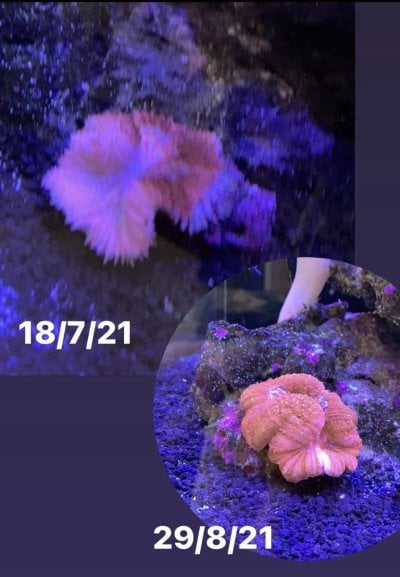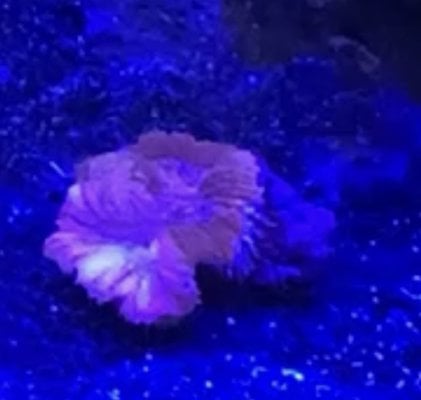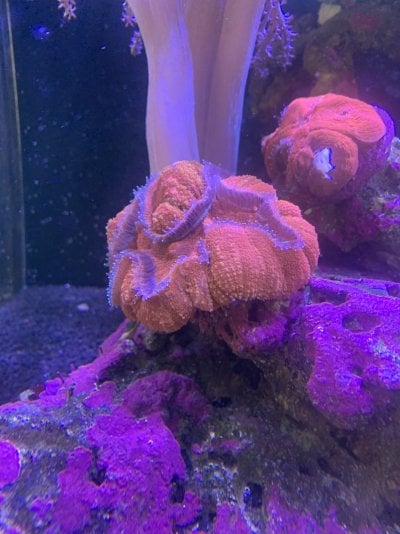Hi all! First thread here. I rarely if ever see any success stories of bringing back brain corals from a certain point of the “dead” on this forum. So I just wanted to share my success story to bring some people hope that it’s possible. Just a warning that some of my description of my coral might be a bit too accurate, read at your own discretion  . Another warning, this is a very long story.
. Another warning, this is a very long story.
My first trachy went through a lot, mostly nitrates that were above 50ppm and very very bad coral placement. I think the biggest factor that caused it to shrink back and bleach was flow and light. I put it at a place that had large amounts of flow and medium-high light. It went from a perfectly healthy trachy to one that barely had any flesh and it was bleached. It literally looked like the “skin” was barely covering the skeleton, with some of the existing skeleton already poking through it. I’ve attached some pictures so hopefully you know what I mean.
I then moved it to an area where there was barely any flow and almost no light. I thought that with the amount of bleaching, it couldn’t photosynthesise anyways, and algae was already growing on top of parts of its skin. I tried everything from direct feeding aminos, to reef roids and even live baby brine. I can’t say for sure if a certain food helped it actually recover or stressed it out even more at that time, but after a certain period of time I gave up. At that time, it had so little flesh that it’s mouth was permanently open. And feeding it always either didn’t have a response, or caused it to retract even further(more skeleton would poke through the skin). I gave up feeding it and thought that I would see it go. Left it alone, forgot about it and continued my maintanence and looking at other corals in the tank. At that time I was doing 30% water changes every week, and cleaning a portion of the sand every other week(but avoided touching it), feeding my fish a combination of mysis, flakes, and a combination of different pellets once a day.
Target Feedin
One day, maybe two weeks later, I was target feeding my other corals when I looked at my trachy, it had inflated the tiniest bit from before but it’s mouth was still open. *I theorise that what it needed was stable water parameters to get used to its new environment after being moved to a low flow low light area.* Back to the story, I added a drop of reef roids on top of it *thinking that it was going to die anyways so why not* and to my surprise, it’s mouth starting to open even further. I was worried that I stressed it out even more and didn’t feed it. Then the next day it inflated just a bit more than before. When I realised that it was starting to eat and react positively to food, I began to feed it tiny amounts. Looking back, the coral was probably so skinny that it probably didn’t have the energy to bring it’s feeding tentacles out so it could only eat food that was literally almost directly on top of its mouth. At that time I fed my corals reef roids once a week. I was very aware that feeding it could possibly make it worse if I fed too much or if the particles were too big. I believed at that time and still believe now that for such a skinny coral, it 1) didn’t need a lot of food at all to function anyways because it was so skinny, and 2) probably digested food very very slowly because again it was sick in a way, so if it digested too slowly the food could rot inside the coral and cause it it’s demise.
Broadcast feeding
At the same time, I was weaning my banggai cardinals to eat frozen. I used live baby brine shrimp as a supplement about 1-2 times a week. I always fed more baby brine shrimp then needed because all the other fishes always went crazy for it too. Upon feeding there was never any change to the trachy, but the next day, it always looked a little better(slightly more inflated). I think because it never fully closed its mouth, it ended up accidentally catching some of that brine shrimp and digesting it.
Reacting to food
After it began to react to food was when it really improved quickly. It went from simply opening its mouth, to being able to excrete mucus to bring more food to its mouth. Slowly but surely, I’d see more and more of these white dots appear along where it’s feeding tentacles are supposed to be. I enjoyed seeing these white dots so much that whenever I fed my fish frozen mysis, I’d gently squirt some of the juice on top of it and watch these white dots peak out *again another theory of mine now, the more frequent it’s feeding tentacles come out(after being able to react to food) the more food it will catch from broadcast fish poo and leftover frozen food, the better and quicker it’s recovery* over time these dots extended further into tentacles. And as it’s flesh inflated, it inflated bringing the algae that was growing on top of it with it. Then after inflating, it slowly unbleached itself, the algae on top of its skin slowly died off, it regained its red colour and over time became less translucent. Now, it’s the most reactive coral to food. The white dots are almost always permanently there and the moment any kind of frozen food(even when pre-rinsed in RO water) is fed to the fish, it’s tentacles come out as if I was direct feeding it! SUCCESS.
My lesson:
Stage 1: most basic factor is water flow, light (assuming other nutrients are kept in check)
Stage 2: broadcast feeding is a good supplement. In my case I broadcast fed live baby brine, along with all the juices of frozen fish food.
Stage 3: direct feeding is the next step up. When it starts to react to food from the broadcast feeding, or being in contact with a little bit of food, I know to start to direct feed. If it retracts back and doesn’t consume the food it’s fed, it’s possibly not ready to eat, and fish will often come and peck leftover food on top of corals which stresses them out even more.
Saving this trachy could’ve been a single factor or a combination factors. I’m explaining this story from my very unscientific perspective purely based on my observation and experience with this single trachy but what factors really saved it is up to interpretation to you. Just wanted to put it out there that it’s possible to save trachys from this stage of bleaching and stress! Sorry for the bad quality pictures, I am obviously terrible at photography there’s actually a bit more to this story but I might save it for another time. This is the main thing. Feel free to leave any questions comments whether this was a stroke of luck :shrug:
there’s actually a bit more to this story but I might save it for another time. This is the main thing. Feel free to leave any questions comments whether this was a stroke of luck :shrug:


My first trachy went through a lot, mostly nitrates that were above 50ppm and very very bad coral placement. I think the biggest factor that caused it to shrink back and bleach was flow and light. I put it at a place that had large amounts of flow and medium-high light. It went from a perfectly healthy trachy to one that barely had any flesh and it was bleached. It literally looked like the “skin” was barely covering the skeleton, with some of the existing skeleton already poking through it. I’ve attached some pictures so hopefully you know what I mean.
I then moved it to an area where there was barely any flow and almost no light. I thought that with the amount of bleaching, it couldn’t photosynthesise anyways, and algae was already growing on top of parts of its skin. I tried everything from direct feeding aminos, to reef roids and even live baby brine. I can’t say for sure if a certain food helped it actually recover or stressed it out even more at that time, but after a certain period of time I gave up. At that time, it had so little flesh that it’s mouth was permanently open. And feeding it always either didn’t have a response, or caused it to retract even further(more skeleton would poke through the skin). I gave up feeding it and thought that I would see it go. Left it alone, forgot about it and continued my maintanence and looking at other corals in the tank. At that time I was doing 30% water changes every week, and cleaning a portion of the sand every other week(but avoided touching it), feeding my fish a combination of mysis, flakes, and a combination of different pellets once a day.
Target Feedin
One day, maybe two weeks later, I was target feeding my other corals when I looked at my trachy, it had inflated the tiniest bit from before but it’s mouth was still open. *I theorise that what it needed was stable water parameters to get used to its new environment after being moved to a low flow low light area.* Back to the story, I added a drop of reef roids on top of it *thinking that it was going to die anyways so why not* and to my surprise, it’s mouth starting to open even further. I was worried that I stressed it out even more and didn’t feed it. Then the next day it inflated just a bit more than before. When I realised that it was starting to eat and react positively to food, I began to feed it tiny amounts. Looking back, the coral was probably so skinny that it probably didn’t have the energy to bring it’s feeding tentacles out so it could only eat food that was literally almost directly on top of its mouth. At that time I fed my corals reef roids once a week. I was very aware that feeding it could possibly make it worse if I fed too much or if the particles were too big. I believed at that time and still believe now that for such a skinny coral, it 1) didn’t need a lot of food at all to function anyways because it was so skinny, and 2) probably digested food very very slowly because again it was sick in a way, so if it digested too slowly the food could rot inside the coral and cause it it’s demise.
Broadcast feeding
At the same time, I was weaning my banggai cardinals to eat frozen. I used live baby brine shrimp as a supplement about 1-2 times a week. I always fed more baby brine shrimp then needed because all the other fishes always went crazy for it too. Upon feeding there was never any change to the trachy, but the next day, it always looked a little better(slightly more inflated). I think because it never fully closed its mouth, it ended up accidentally catching some of that brine shrimp and digesting it.
Reacting to food
After it began to react to food was when it really improved quickly. It went from simply opening its mouth, to being able to excrete mucus to bring more food to its mouth. Slowly but surely, I’d see more and more of these white dots appear along where it’s feeding tentacles are supposed to be. I enjoyed seeing these white dots so much that whenever I fed my fish frozen mysis, I’d gently squirt some of the juice on top of it and watch these white dots peak out *again another theory of mine now, the more frequent it’s feeding tentacles come out(after being able to react to food) the more food it will catch from broadcast fish poo and leftover frozen food, the better and quicker it’s recovery* over time these dots extended further into tentacles. And as it’s flesh inflated, it inflated bringing the algae that was growing on top of it with it. Then after inflating, it slowly unbleached itself, the algae on top of its skin slowly died off, it regained its red colour and over time became less translucent. Now, it’s the most reactive coral to food. The white dots are almost always permanently there and the moment any kind of frozen food(even when pre-rinsed in RO water) is fed to the fish, it’s tentacles come out as if I was direct feeding it! SUCCESS.
My lesson:
Stage 1: most basic factor is water flow, light (assuming other nutrients are kept in check)
Stage 2: broadcast feeding is a good supplement. In my case I broadcast fed live baby brine, along with all the juices of frozen fish food.
Stage 3: direct feeding is the next step up. When it starts to react to food from the broadcast feeding, or being in contact with a little bit of food, I know to start to direct feed. If it retracts back and doesn’t consume the food it’s fed, it’s possibly not ready to eat, and fish will often come and peck leftover food on top of corals which stresses them out even more.
Saving this trachy could’ve been a single factor or a combination factors. I’m explaining this story from my very unscientific perspective purely based on my observation and experience with this single trachy but what factors really saved it is up to interpretation to you. Just wanted to put it out there that it’s possible to save trachys from this stage of bleaching and stress! Sorry for the bad quality pictures, I am obviously terrible at photography

















